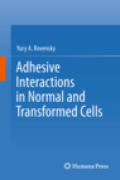
Adhesive Interactions in Normal and Transformed Cells describes the basic mechanisms of the ability of tissue cells to attach to each other and to the extracellular matrix. These adhesive interactions are pivotal regulators of main cellular functions, such as proliferation, survival and migration. The adhesiveinteractions are involved in embryonic development, regeneration, and also ininflammation and degeneration processes, which are at the basis of many diseases. Serious alterations in cell adhesion caused by the oncogenic transformation play a key role in cancer invasion and metastasis. This volume provides comprehensive information about structural, mechanistic and signaling aspects of adhesive interactions in both normal and cancer cells in comparison. Integration of such aspects of the adhesive process as structure, relation to cell systems of receptors and cytoskeleton, function, signaling pathways, and the alterations in tumor cells constitutes the strongest point of this work. The results of the long-time author’s research are included in the book. The author was one of pioneers, who used scanning electron microscopy (SEM) to study the cellsurface morphology of normal cultured cells and the cells underwent the oncogenic transformation, processes of their attachment to and spreading on the surfaces of a solid substratum, and also surprising ability of the cells to respond to various geometric configurations of the substrata surfaces.. Adhesive Interactions in Normal and Transformed Cells has both biological and medical aspects and, therefore, it can be interesting not only for cell biologists, developmental biologists and cancer researchers, but also for physicians. It is intended for researchers, postdocs, undergraduate and graduate students. Describes the basic mechanisms of the ability of tissue cells to attach toeach other and to the extracellular matrix. Provides comprehensive information about structural, mechanistic and signaling aspects of adhesive interactionsin both normal and cancer cells in comparison. Presents both biological and medical aspects. INDICE: Introduction. The Extracellular Matrix. Cytoskeleton. Pseudopodia and Adhesion Structures. Adhesive Interactions of Tissue Cells with the Extracellular Matrix. Cell Migration. Cell Responses to Chemical Heterogeneity of Substrata: Adhesive “Islets” or “Paths”. Topographic Cell Responses. Intercellular Adhesive Interactions. Conclusions.
- ISBN: 978-1-61779-303-5
- Editorial: Humana Press
- Encuadernacion: Cartoné
- Páginas: 215
- Fecha Publicación: 28/10/2011
- Nº Volúmenes: 1
- Idioma: Inglés
